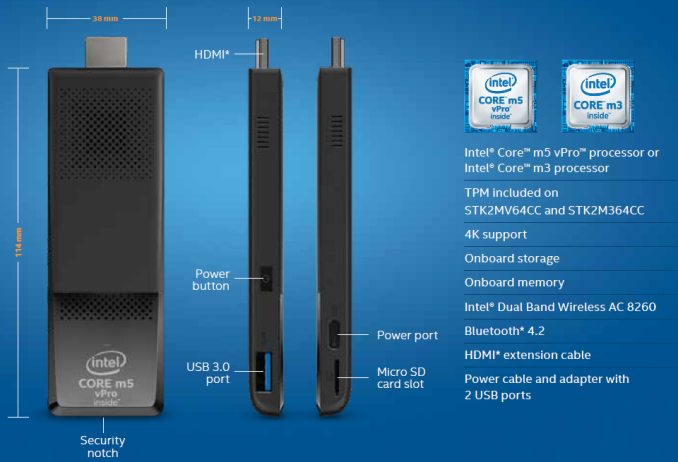The Intel Compute Stick (Core m3-6Y30) Review
by Ganesh T S on June 27, 2016 8:00 AM EST- Posted in
- Systems
- Intel
- Core M
- Skylake
- HDMI Stick
- Compute Stick
Miscellaneous Aspects and Concluding Remarks
Intel has also been putting some effort on the software side for the Compute Stick platform. One of the main problems with the platform is the limited availability of USB ports. This is somewhat alleviated in the Core M version, thanks to the two USB 3.0 ports in the power adapter. In certain situations (such as the 'entertainment' use-case), the consumer often has a second screen available (either a tablet or a smartphone). Intel has a free Android / iOS app - the Intel Remote Keyboard - to take advantage of the second screen.
The host application comes pre-installed on the Compute Stick and is active at startup as a service. Therefore, one can use it to even enter credentials for system login. It allows the second screen keyboard to act as the primary keyboard for the Compute Stick and the screen itself to act as a trackpad for the mouse pointer on the Compute Stick's display. In our evaluation, the app worked well. Our only wish is for the in-built keyboard in the app to have a 'Tab' key, and the keyboard to work properly when using a Powershell or Command Prompt window.
Moving on to the business end of the review, we complained in our previous Compute Stick reviews that 32GB of primary storage does not cut it on any computing device other than a tablet or smartphone. Fortunately, the Core m3-6Y30 Compute Stick solves that problem. The two USB 3.0 ports on the power adapter are very welcome. The Wi-Fi solution (2x2 AC8260 802.11ac PCIe WLAN) is also top-notch. The system is also able to bitstream HD audio for HTPC applications. BIOS options t have fine-grained control over the fans is also a nice aspect. Performance-wise, it is hard to find faults when keeping the form factor in mind.
The only complaint we have is the $390 price point. Even though that price includes the OS license, we find it difficult to recommend it in the home PC market - the Cherry Trail Compute Stick and the other sub-$150 Compute Sticks look to be a better option.
However, the SMB / enterprise market might find the Core M Compute Sticks more to their liking. Price is not such a huge deterrent in that market. The availability of vPro features (in the Core m5 model) and TPM (trusted platform module) shows that Intel intends these systems to be primarily adopted in that market segment.











105 Comments
View All Comments
okenny - Sunday, July 3, 2016 - link
True.what's with all the SSD reviews? I don't understand why SSDs are so interesting, an upgrade makes little or no difference to system performance unless you move from HDD to SSD or maybe from SATA to NVMe on PCIe or m.2. Don't get it.
okenny - Sunday, July 3, 2016 - link
hmmmm....no HDMI 2.0 at this price point, I'd buy something else like an nVidia Shield.Though I'd prefer Windows.
jakoh - Thursday, December 20, 2018 - link
How does this perform with 1080p Hevc?How is the H265 performance?
jakoh - Thursday, December 27, 2018 - link
Replying here, it’s remarkable at playing hevc content 1080p tested upto 2mbps. So happy with the performance. Thank you intel. It’s my dream media player.I am running Ubuntu 18. So easy to setup.
yeeeeman - Sunday, June 28, 2020 - link
Intel needs to make a lakefield version of this.